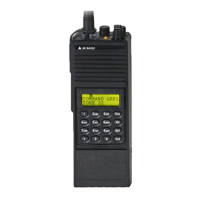Operation GPH-CMD VHF Radio
Page 3-4 BK RADIO
Operating Instructions:
• Transmit no more than the rated duty factor of 50% of the time. To transmit (talk), push
the Push-To-Talk (PTT) button. To receive calls, release the PTT button. Transmitting
50% of the time, or less, is important because this radio generates measurable RF
energy exposure only when transmitting (in terms of measuring for standards
compliance).
• Hold the radio in a vertical position in front of face with the microphone (and the other
parts of the radio, including the antenna) at least one inch (2.5 cm) away from the
nose. Keeping the radio at the proper distance is important because RF exposures
decrease with distance from the antenna. Antenna should be kept away from eyes.
• When worn on the body, always place the radio in a BK Radio approved clip, holder,
holster, case, or body harness for this product. Using approved body-worn accessories
is important because the use of BK Radio or other manufacturer’s non-approved
accessories may result in exposure levels which exceed the FCC’s
occupational/controlled environment RF exposure limits.
• If you are not using a body-worn accessory and are not using the radio in the intended
use position in front of the face, then ensure the antenna and the radio are kept at least
one inch (2.5 cm) from the body when transmitting. Keeping the radio at the proper
distance is important because RF exposures decrease with increasing distance from
the antenna.
• Use only BK Radio approved supplied or replacement antennas, batteries, and
accessories. Use of non-BK Radio approved antennas, batteries, and accessories
may exceed the FCC RF exposure guidelines.
• For a list of BK Radio approved accessories visit the following website:
http://www.relm.com.
CONTACT INFORMATION
For additional information on exposure requirements or other information, visit website
http://www.relm.com
.
3.3 SAFETY PRECAUTIONS
•
Do not operate the transmitter in close proximity to blasting caps.
• Do not operate the radio in an explosive atmosphere (petroleum fuels, solvents,
dust, etc.) unless your radio is an intrinsically safe model designed for such use.

